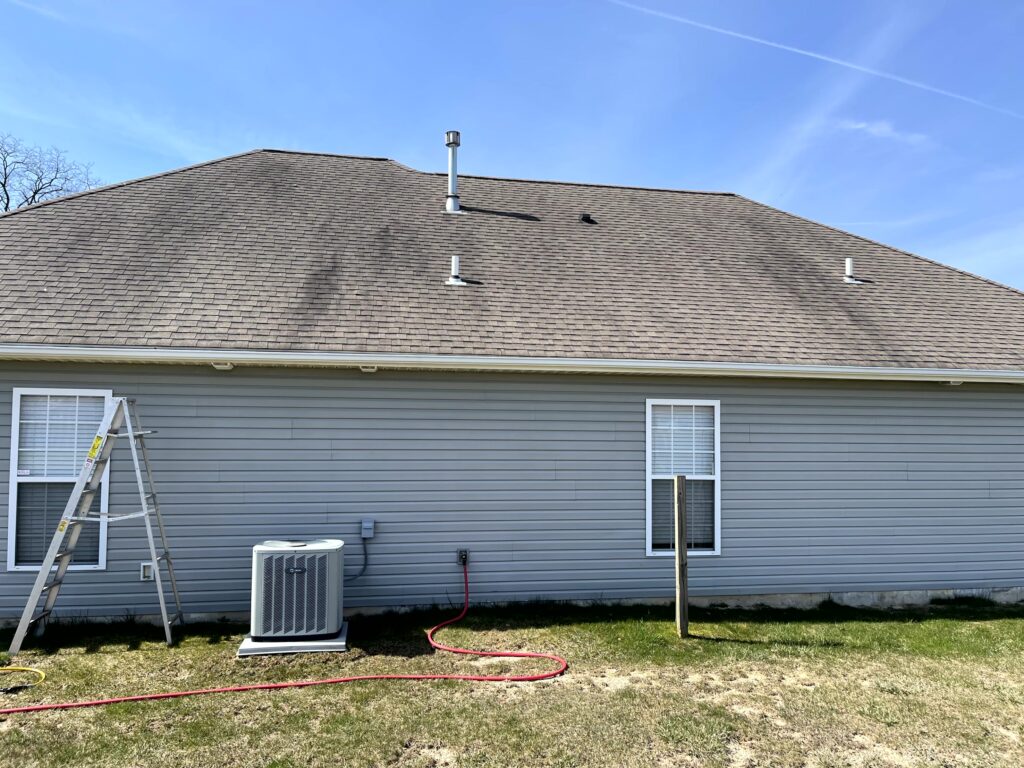
Maintaining a clean, well-preserved roof is essential for protecting a building’s structure and aesthetics. Over time, roofs accumulate dirt, debris, algae, and moss, all of which can damage roofing materials and reduce property value. Regular roof pressure washing, performed with the correct methods and in line with manufacturer guidelines, offers several advantages, from prolonging roof life to improving energy efficiency. Here’s a look at the key benefits, alongside recommendations from top roofing manufacturers.
1. Extending the Lifespan of Roofing Materials
Roofs are subject to the elements, and over time, moss, algae, and lichen can develop. These organisms, often found in shaded or damp areas, can hold moisture, leading to gradual roof degradation. When left unchecked, moss and algae can create microscopic fractures in roofing materials, potentially reducing their lifespan. Pressure washing helps eliminate these growths, reducing wear and allowing the roof to reach its full lifespan.
Manufacturers like GAF Roofing, one of the largest roofing product providers in North America, support periodic pressure washing to preserve roofing materials, particularly when algae or moss are visible. GAF recommends a “soft wash” approach—a low-pressure technique that removes organic growth without compromising the roof’s integrity. According to GAF, this gentle cleaning is suitable for various roof materials, including asphalt shingles, metal roofing, and wood.
2. Enhancing Curb Appeal and Property Value
A roof covered in stains or algae detracts from a property’s overall appearance. Pressure washing can restore the roof’s color, adding to the curb appeal and making the property more attractive to potential buyers. A well-maintained roof is often perceived as an indicator of a cared-for home, which can positively impact property value.
CertainTeed, another leading manufacturer of roofing materials, highlights that clean roofs generally add to a home’s visual appeal and market value. Regular cleaning is especially beneficial for asphalt and composite roofing, which tend to accumulate dark streaks from algae. CertainTeed advises using a low-pressure cleaning approach to avoid damaging the granules that protect asphalt shingles.
3. Improved Energy Efficiency and Temperature Control
Roofs that are covered in dark stains and organic growth retain heat, impacting the roof’s ability to reflect sunlight effectively. This can lead to increased indoor temperatures, particularly during the warmer months, which may drive up cooling costs. Removing algae, moss, and dirt helps the roof reflect sunlight, contributing to a more energy-efficient home.
Owens Corning, a leading roofing and insulation manufacturer, emphasizes that clean roofs are better at reflecting sunlight, helping to maintain comfortable indoor temperatures and reducing energy costs. For this purpose, Owens Corning recommends professional pressure washing, as DIY approaches can sometimes inadvertently damage shingles if improper pressure settings or cleaning solutions are used.
4. Preventing Structural Damage from Water Retention
Accumulated organic growth and debris can lead to clogged gutters, which prevent proper water drainage from the roof. When water does not flow away, it can pool on the roof, causing leaks and potential structural damage. Pressure washing removes this debris and helps gutters and downspouts function properly, reducing the risk of water infiltration.
IKO Roofing, a global leader in roofing materials, warns that clogged gutters can create a backflow of water, potentially leading to structural issues. IKO advises regular roof cleaning in conjunction with gutter cleaning to ensure a clear drainage path. Their recommendation includes using professional services to maintain safe pressure levels, especially for delicate roofing materials such as clay tiles or cedar shakes.
5. Manufacturer-Recommended Techniques and Considerations
Pressure washing, while beneficial, requires care and adherence to industry best practices. Roof manufacturers often recommend specific cleaning techniques to avoid damaging materials. A common approach is soft washing, a low-pressure cleaning method combined with eco-friendly cleaning agents. This is particularly important for materials such as asphalt shingles and clay tiles, which can be damaged by high-pressure settings.
The Asphalt Roofing Manufacturers Association (ARMA) specifically advises against high-pressure washing, noting that it can dislodge granules from asphalt shingles, leading to reduced UV protection and a shorter lifespan. ARMA recommends using non-abrasive, low-pressure washing techniques to protect shingles while still effectively removing contaminants.
Conclusion
Roof pressure washing offers a range of benefits, from extending the life of roofing materials to improving energy efficiency and curb appeal. When carried out professionally and according to manufacturer recommendations, it’s a valuable maintenance step that helps protect your investment. As leading manufacturers emphasize, selecting the correct pressure and cleaning method is essential to avoid compromising the integrity of roofing materials. For optimal results, professional roof pressure washing services are recommended, as they understand the nuances of different roofing types and can tailor their methods accordingly.
Regular, careful roof cleaning not only preserves the aesthetic and functional qualities of your roof but also safeguards your home’s long-term value.
